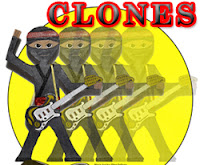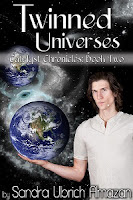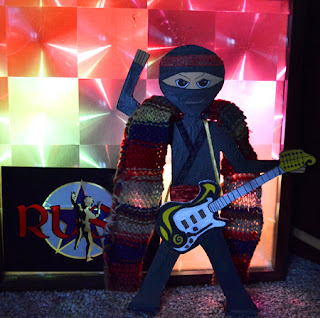Today I’d like to welcome fellow science fiction author, Sandra Ulbrich Almazan! Sandra knows her science and she’s here to share about clones. (Yes – clones!)
Are Clones Really Identical to the People They're Cloned From?

Clones, twins, and other types of doubles make for interesting fiction because they allow us to explore questions of identity. How much of what makes us unique is determined by our genes, and how much by our environment? One way to answer this question is by looking at people who have identical genes, whether they're natural twins or an "original" person (whom I'll refer to as the DNA donor) and the clone created from him or her. However, DNA donors and clones may differ from each other in unexpected ways.
Most of the DNA in each human cell is in the nucleus. Humans have twenty-two pairs of autosomal chromosomes (identical in form and genes) and one pair of sex-determining chromosomes. If you uncoiled the DNA in the chromosomes and laid them all end-to-end, the strand would stretch out for about six feet. It's a marvel of packaging that all this DNA fits into a space six micrometers (millionths of a meter) across. Surprisingly, most of this DNA isn't what we consider a gene: a stretch of DNA that codes for a protein or part of a protein. There are about 20,000 genes in the human genome, comparable to other animals. Many of the non-coding regions of DNA regulate how the genes are expressed.
When an organism is cloned, the nuclear DNA is copied and inserted into a receptive egg (one that had its own DNA removed). However, there is DNA outside the cell nucleus in special organelles called mitochondria. Mitochondria are involved in the final steps of breaking down food to produce energy. They are thought to be ancient bacteria that became incorporated into eukaryotic (cells with nuclei) cells. Mitochondria still have their own independent DNA, and this DNA does play a role in certain human metabolism diseases. However, mitochondria are not normally transferred from the DNA donor to the clone. I did specifically mention in Lyon's Legacy that when Sean Lyon, a famous TwenCen musician, was cloned, his mitochondria were introduced into the egg along with his DNA. However, not all of the mitochondria from the egg were removed, so the clone will have both Sean's mitochondria and his mother's.

I mentioned earlier that there are many regions of DNA that regulate other parts, the genes. However, DNA can also be regulated by other means. In fact, there is a science called epigenetics that studies how gene expression can be changed by means other than changing the code in the DNA sequence. One way this can be done is by methyl (CH3, or a carbon atom bonded to three hydrogen atoms) tags attached to certain bases. Among other things, these tags can indicate which parent a person inherited a gene from and make it more or less active. This in turn may affect whether a person is diseased or healthy.
How does epigenetics affect a clone? For starters, if the methyl markers or other types of DNA modification are changed by the cloning process, the clone may fail to develop properly--or at all. But epigenetics aren't just inherited; they can change in response to the environment. I don't get into technical detail about epigenetics in Lyon's Legacy and Twinned Universes. However, I do point out that they are raised in very different environments, with the clone, Paul, growing up in a more stable home and with access to all the futuristic ideas about child rearing. How is he similar to his DNA donor, and how does he differ? You'll have to read Lyon's Legacy and Twinned Universes to find out.
Thanks to Alex for having me here today, and thanks to his Ninja Army for reading this. Please let me know if you have any questions.
Find Sandra HERE and purchase Twinned Univers e at Amazon, Barnes and Noble, and Smashwords.

Ninja News
TF Walsh just signed with agent Gina Panettieri of Talcott Notch Literary. Congratulations, TF!
Tyrean Martinson’s Dragonfold and Other Adventures is now available in paperback. Congratulations, Tyrean!
Thrill of it All Blogfest
Hosted by the awesome Tara Tyler and Heather Gardner.
The ladies are looking for a thrill.
And what could be more thrilling than Mini-Alex’s first concert?
It was his big moment. His first live performance of Rush’s YYZ.
Would his fingers cooperate? Would he hit all the correct strings? Frantic and in the zone, he tore through the riff.
Score!!!! He nailed it.
And the crowd went wild…
Trivia Answers
And the directors are…
1 – The Untouchables 1987 – Brian DePalma
2 – Groundhog Day 1993 – Harold Ramis
3 – The Usual Suspects 1995 – Bryan Singer
4 – Hugo 2011 – Martin Scorsese
5 – The 13th Warrior 1999 – John McTiernan
6 – Rango 2011 – Gore Verbinksi
Movie Review

World War Z
This is a different take on the zombie genre but not completely unfamiliar.
There are some genuine chilling moments. The set pieces and action sequences were really well done, especially Jerusalem.
Brad Pitt was good. He really cared about his family and we were invested in the story.
It’s PG-13 for a reason – it’s a bloodless affair. For a zombie movie, that was an odd choice. The Walking Dead is ten times gorier.
The ending was a bit of a head scratcher. I thought they said that no matter what, he was… Sorry, don’t want to give away the ending.
Half the time, people seemed to be dying because Brad Pitt was there. (Mental note – during a real zombie apocalypse, stay away from Brad Pitt.)
My final beef – the trailer revealed too much, including all of the money shots.
Lest you think I’m bashing this film, I must say that overall it was very effective and entertaining. It’s less a zombie film and more of an action-drama. It won’t break any new ground in the zombie genre but you will be entertained for two hours.
Did you learn something new about clones today? What is the big thrill in your life? Get the trivia correct? And who else saw World War Z?











